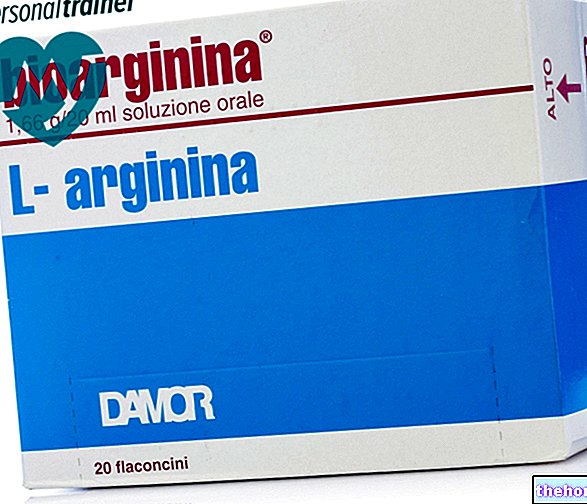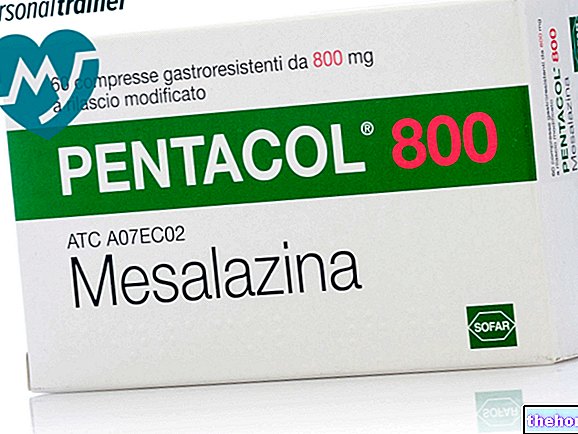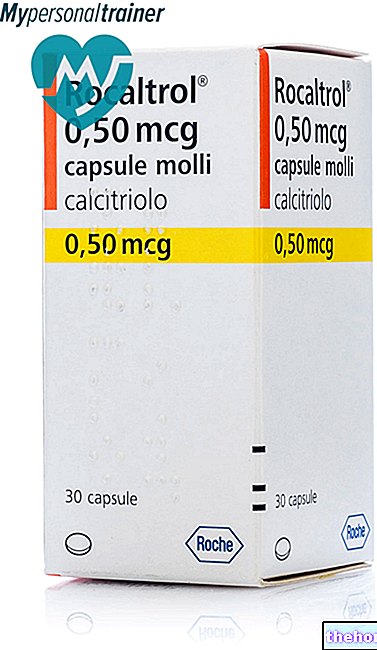Active ingredients: Naloxone (naloxone hydrochloride)
NARCAN® 0.4 mg solution for injection
Why is Narcan used? What is it for?
PHARMACOTHERAPEUTIC CATEGORY
Antidote of narcotic analgesics
THERAPEUTIC INDICATIONS
Antidote in the treatment of acute poisoning from analgesics, narcotics. It should be borne in mind that the symptoms of acute opioid intoxication are represented by: respiratory depression, comatose state (precoma or alert coma and in the most serious cases of a deep type), pupillary miosis (absent in case of simultaneous intake of substances with mydriatic effect , in cases of acute meperidine intoxication and in the terminal states of coma).
INFORMATION ON THE USE OF THE MEDICINAL PRODUCT
NARCAN (naloxone hydrochloride) is a drug antagonist synthesis molecule, derived from "oxymorphone. NARCAN is a pure antagonist of natural and synthetic drugs: it does not possess" agonistic "or morphine-like properties, characteristic of other drug antagonists. NARCAN it does not cause psychotomimetic effects, respiratory depression or miosis. Administered intravenously, the activity of NARCAN is generally evident after two minutes; the onset of pharmacological activity is only slightly slowed if the product is administered subcutaneously or intromuscularly.
The duration of the activity is dose-dependent and correlated to the route of administration; the pharmacological effects are however more prolonged after intramuscular administration than those obtainable by the intravenous route. The need to administer repeated doses of NARCAN may depend on the type, the quantity and route of administration of the drug to be antagonized.
In people who have established physical dependence on drugs, NARCAN can cause withdrawal syndrome. NARCAN does not cause any physical or psychological addiction or addiction. In subjects who have not taken drugs or antagonistic products of the same, NARCAN does not show any pharmacological effect.
Precautions for use What you need to know before taking Narcan
- NARCAN should be administered with caution to people who are known (or suspected) to be opioid dependent, including infants of drug addict or suspect mothers. In these cases, in fact, an "immediate withdrawal syndrome occurs.
- NARCAN should be administered with caution in patients with cardiac disorders.
- The administration of vasopressor drugs and resuscitation techniques, such as maintaining a patent airway, artificial respiration and cardiac massage, can be combined to counteract acute drug poisoning.
Warnings It is important to know that:
- In pregnant women, administer only in case of real need and under the direct supervision of the doctor.
- NARCAN is not effective against respiratory depression due to non-opioid drugs.
- It is necessary to carefully observe the patient after awakening for up to 3-6 hours in case of acute heroin intoxication and up to 24-48 hours in case of acute methadone intoxication. It is possible that respiratory depression may reappear and that the patient returns to a coma after administration of the first effective dose of NARCAN, because the duration of the antagonist action (20-30 minutes after intravenous administration; 2.5 hours - 3 hours after intramuscular or subcutaneous administration) may be shorter than that of the substance injected opiate, varying from time to time (heroin, morphine, methadone, pentazocine, etc.).
It may therefore be necessary to administer further doses of NARCAN after the first effective administration.
After the first intervention, it is therefore necessary to transfer the patient to a hospital setting also for the timely treatment of any complications that cannot be antagonized with naloxone (pulmonary edema, circulatory complications, toxic and pathological effects from adulterating substances or other drugs taken at the same time , other pathologies in progress which have become worse, etc.).
Dosage and method of use How to use Narcan: Dosage
NARCAN can be administered intravenously, subcutaneously or intramuscularly. Intravenous administration, recommended in emergency situations, determines a more rapid onset of pharmacological activity, since the duration of the pharmacological effects of some drugs could exceed that of NARCAN, the patient should be constantly monitored and, if necessary, the administration of the drug should be repeated.However, it is recommended to always refer the patient, as soon as possible, to an equipped emergency room.
ADULTS
- Narcotic overdose (known or suspected):
The starting dose of NARCAN, administered intravenously, intramuscularly or subcutaneously is 0.4 mg (1 ml). In the event that after intravenous administration there is not a sufficient improvement in respiratory function, it is advisable to repeat the dose at intervals of 2-3 minutes. A poor improvement after administration of 2-3 doses of NARCAN, could be caused by any concomitant morbid processes or the presence of non-opioid drugs.
- Post-operative drug depression:
To achieve partial or complete antagonism of the depressing effects of opioids following surgery, a lower dose of NARCAN is required. However, this must be established in relation to the patient's response.
NARCAN should be administered intravenously, in increasing doses between 0.1-0.2 mg, with 2-3 minute intervals, until adequate antagonism of the depressing effects induced by drugs is obtained. Within 1-2 hours of the first administration, it may be necessary to repeat the administration of NARCAN, depending on the type, quantity and time interval since the last drug administration.
Additional doses of NARCAN intramuscularly, however, determine a more prolonged effect. Excessive doses of NARCAN can cause a significant decrease in the analgesic effect induced by the drug and increase blood pressure. Similarly, too rapid antagonism could induce nausea, vomiting, sweating or tachycardia.
CHILDREN
Narcotic overdose (known or suspected): The starting dose is 0.01 mg / kg administered intravenously, intramuscularly or subcutaneously. The dose can be repeated according to the directions for administration in adults. If necessary, NARCAN can be diluted in sterile distilled water.
Side Effects What are the side effects of Narcan
No side effects have been reported, except the appearance of nausea and vomiting in subjects undergoing surgery, treated with NARCAN at doses higher than those recommended.In any case, any undesirable effect other than those described above should be communicated to the attending physician or pharmacist.
Expiry and Retention
WARNING: Do not use the medicine after the expiry date indicated on the package.
The expiry date indicated on the package refers to the product in intact packaging, correctly stored.
COMPOSITION
Active ingredient: 0.4 mg naloxone hydrochloride
Excipients: sodium chloride, methyl p-hydroxybenzoate, propyl p-hydroxybenzoate, water for injections
PHARMACEUTICAL FORM AND PACKAGING
1 vial of 1 ml containing 0.4 mg of naloxone chloride
Source Package Leaflet: AIFA (Italian Medicines Agency). Content published in January 2016. The information present may not be up-to-date.
To have access to the most up-to-date version, it is advisable to access the AIFA (Italian Medicines Agency) website. Disclaimer and useful information.
01.0 NAME OF THE MEDICINAL PRODUCT
NARCAN
02.0 QUALITATIVE AND QUANTITATIVE COMPOSITION
NARCAN
Each ampoule contains: active ingredient: naloxone hydrochloride 0.4 mg
NARCAN NEONATAL
Each ampoule contains: active ingredient: naloxone hydrochloride 0.04 mg
03.0 PHARMACEUTICAL FORM
Injectable solution
04.0 CLINICAL INFORMATION
04.1 Therapeutic indications
NARCAN
Antidote in the treatment of acute poisoning from analgesics, narcotics. It should be borne in mind that the symptoms of acute opioid intoxication are represented by: respiratory depression, comatose state (precoma or alert coma and in the most serious cases of a deep type) pupillary miosis (absent in case of simultaneous intake of substances with mydriatic effect, in cases of acute meperidine intoxication and in the terminal states of coma).
NARCAN NEONATAL
Respiratory depression of the newborn caused by the use of opioid substances by the drug addict mother before delivery.
04.2 Posology and method of administration
NARCAN
NARCAN can be administered intravenously, subcutaneously or intramuscularly.
Intravenous administration, recommended in emergency situations, results in a more rapid onset of pharmacological activity. Since the duration of the pharmacological effects of some drugs may exceed that of NARCAN, the patient should be constantly monitored and, if necessary, the administration of the drug should be repeated.
However, it is recommended to always refer the patient, as soon as possible, to an equipped emergency room.
Adults:
Narcotic overdose (known or suspected):
The starting dose of NARCAN, administered intravenously, intramuscularly or subcutaneously is 0.4 mg (1 ml). In the event that after intravenous administration there is not a sufficient improvement in respiratory function, it is advisable to repeat the dose at intervals of 2-3 minutes.
A poor improvement after administration of 2-3 doses of NARCAN, could be caused by any concomitant disease processes or by the presence of non-opioid drugs.
Post-operative drug depression:
To achieve partial or complete antagonism of the depressing effects of opioids following surgery, a lower dose of NARCAN is required. However, this must be established in relation to the patient's response.
NARCAN should be administered intravenously, in increasing doses between 0.1 0.2 mg, with 2-3 minute intervals, until adequate antagonism of the depressing effects induced by drugs is obtained. Within 1-2 hours of the first administration, it may be necessary to repeat the administration of NARCAN, depending on the type, quantity and time interval since the last drug administration.
Additional doses of NARCAN intramuscularly, however, determine a more prolonged effect.
Excessive doses of NARCAN can cause a significant decrease in the analgesic effect induced by the drug and increase blood pressure. Similarly, too rapid antagonism could induce nausea, vomiting, sweating or tachycardia.
Children:
Narcotic overdose (known or suspected):
The starting dose is 0.01 mg / kg administered intravenously, intramuscularly or subcutaneously.
The dose can be repeated according to the directions for administration in adults.
If necessary, NARCAN can be diluted in sterile distilled water.
NARCAN NEONATAL
The starting dose is 0.01 mg / kg administered intravenously, intramuscularly or subcutaneously.
Intravenous administration, recommended in an emergency situation, causes a more rapid onset of pharmacological effects. As the duration of effects of some drugs may exceed that of NARCAN NEONATAL, the neonate should be closely monitored and, if necessary, the drug should be repeated at 2-3 minute intervals.
A poor improvement after administration of 2-3 doses, could be caused by any morbid processes of other origin.
04.3 Contraindications
Hypersensitivity to the drug.
04.4 Special warnings and appropriate precautions for use
NARCAN is not effective against respiratory depression due to non-opioid drugs.
The patient should be carefully observed after awakening for up to 3-6 hours in case of acute heroin intoxication and up to 24-48 hours in case of acute methadone intoxication.
In fact, it is possible that respiratory depression reappears and that the patient returns to coma after administration of the first effective dose of NARCAN, because of the duration of the antagonist action (20-30 minutes after intravenous administration; 2 and a half-3 hours after intramuscular administration or subcutaneous) may be lower than that of the injected opiate substance, varying from time to time (heroin, morphine, methadone, pentazocine, etc.).
It may therefore be necessary to administer further doses of NARCAN after the first effective administration.
After the first intervention, it is therefore necessary to transfer the patient to a hospital environment also for prompt treatment
NARCAN should be administered with caution in patients with cardiac disorders.
The administration of vasopressor drugs and resuscitation techniques, such as maintaining a patent airway, artificial respiration and cardiac massage, can be combined to counteract acute drug poisoning.
04.5 Interactions with other medicinal products and other forms of interaction
There are no known interactions with other drugs.
04.6 Pregnancy and lactation
In pregnant women, administer only in case of real need and under the direct supervision of the doctor.
04.7 Effects on ability to drive and use machines
Nobody.
04.8 Undesirable effects
No major side effects have been reported, but only the onset of nausea and vomiting in subjects undergoing surgery, treated with NARCAN at higher than recommended doses.
The drug does not cause any physical or psychological addiction or addiction.
04.9 Overdose
NARCAN has no agonist effects on opiate receptors. In the absence of substances with a morphine-like effect, in man, no subjective or objective effects were noted up to doses of 12 mg (30 ampoules), while up to doses of 24 mg (60 ampoules) only a slight drowsiness.
05.0 PHARMACOLOGICAL PROPERTIES
05.1 Pharmacodynamic properties
Naloxone is a synthetic molecule derived from oxymorphone by replacing the methyl group on the nitrogen atom with an allyl group. Naloxone is an antagonist of natural and synthetic drugs, acting with a competitive mechanism at the level of the receptors on which morphine-like substances act, that is, it does not possess agonistic or morphine-like properties, characteristics of other drug antagonists.
Naloxone does not cause psychotomimetic effects, respiratory depression or miosis.
In subjects who have not taken drugs or antagonistic products of the same, naloxone does not show any pharmacological effect. The need to administer repeated doses of the drug may depend on the type, quantity and route of administration of the drug to be antagonized.
05.2 Pharmacokinetic properties
Following intravenous administration, the activity of naloxone is generally evident after 2 minutes. The onset of pharmacological activity is slightly slowed if the product is administered subcutaneously or intramuscularly. The duration of the activity is dose-dependent and correlated to the route of administration; the pharmacological effects are however more prolonged after intramuscular administration than those obtainable by the intravenous route.
05.3 Preclinical safety data
LD50 (mg / kg):
mouse: i.v. = 150, i.p. = 80, s.c. = 286
rat: i.v. = 109, s.c. = 640
Administration s.c. for three weeks of 10 mg / kg / day in rats showed no toxic effects.
There were also no alterations in fertility (in the rat) or teratogenic or embryotoxic effects after SC injection. of 2-10 mg / kg / day.
06.0 PHARMACEUTICAL INFORMATION
06.1 Excipients
Sodium chloride, methyl p-hydroxybenzoate, propyl p-hydroxybenzoate, water p.p.i.
06.2 Incompatibility
None.
06.3 Period of validity
3 years.
06.4 Special precautions for storage
None.
06.5 Nature of the immediate packaging and contents of the package
NARCAN
1ml Neutral Glass Vial: Pack of 1 0.4mg / 1ml vial
NARCAN NEONATAL
2ml Neutral Glass Vial: Pack of 1 0.04mg / 2ml vial.
06.6 Instructions for use and handling
-----
07.0 MARKETING AUTHORIZATION HOLDER
Sirton Medicare S.r.l. - Piazza XX Settembre 2 - Villa Guardia (Como)
08.0 MARKETING AUTHORIZATION NUMBER
NARCAN - A.I.C. n. 023976018
NARCAN NEONATAL - A.I.C. n. 023976020
09.0 DATE OF FIRST AUTHORIZATION OR RENEWAL OF THE AUTHORIZATION
September 1979 / Renewal: June 2005
10.0 DATE OF REVISION OF THE TEXT
01/06/2005




























